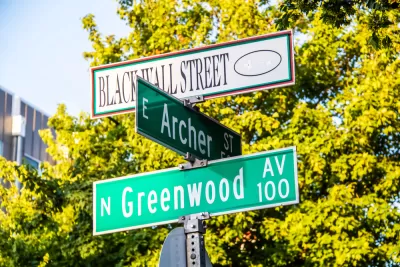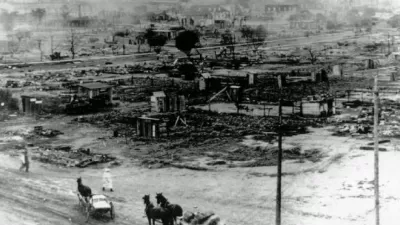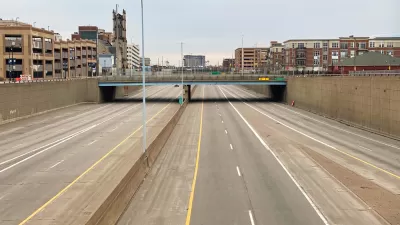After the Tulsa Race Massacre, Greenwood rebuilt strong. Then came "urban renewal."

The Tulsa Daily World’s June 2, 1921 morning edition headline read: “Dead Estimated at 100: City is Quiet. $2000 to Start Fund for Relief. Negros Gladly Accept Guards. 5,000 Negro Refugees Guarded in Camp at County Fairgrounds.”
Fewer than 24 hours after Ku Klux Klan leaders — along with the Tulsa Police Department and the Oklahoma National Guard — carried out the nation’s deadliest and most destructive massacre, Tulsa’s paper of record was already at work crafting a narrative that would shape the way that the city would think about the massacre in Greenwood for the next 100 years.
Thanks to recent scholarship and pop culture depictions of the massacre in Greenwood, more and more Americans are coming to know the story of the Tulsa Race Massacre that destroyed Black Wall Street. But the common narrative — that the massacre destroyed the neighborhood and it never recovered — is incorrect. In fact, Greenwood’s resilient residents rebuilt their community almost immediately after the massacre — in defiance of hastily-enacted racist zoning codes — giving rise to the popular use of the neighborhood’s moniker of Black Wall Street after, not before, the massacre. And while a price cannot be put on the 300 lives lost, the violence that really destroyed Black Wall Street wasn’t physical, but structural.
FULL STORY: Black Wall Street's Second Destruction

Planetizen Federal Action Tracker
A weekly monitor of how Trump’s orders and actions are impacting planners and planning in America.

Congressman Proposes Bill to Rename DC Metro “Trump Train”
The Make Autorail Great Again Act would withhold federal funding to the system until the Washington Metropolitan Area Transit Authority (WMATA), rebrands as the Washington Metropolitan Authority for Greater Access (WMAGA).

DARTSpace Platform Streamlines Dallas TOD Application Process
The Dallas transit agency hopes a shorter permitting timeline will boost transit-oriented development around rail stations.

Supreme Court Ruling in Pipeline Case Guts Federal Environmental Law
The decision limits the scope of a federal law that mandates extensive environmental impact reviews of energy, infrastructure, and transportation projects.

Texas State Bills to Defund Dallas Transit Die
DART would have seen a 30% service cut, $230M annual losses had the bills survived.

Bikeshare for the Win: Team Pedals to London Cricket Match, Beats Rivals Stuck in Traffic
While their opponents sat in gridlock, England's national cricket team hopped Lime bikes, riding to a 3-0 victory.
Urban Design for Planners 1: Software Tools
This six-course series explores essential urban design concepts using open source software and equips planners with the tools they need to participate fully in the urban design process.
Planning for Universal Design
Learn the tools for implementing Universal Design in planning regulations.
Roanoke Valley-Alleghany Regional Commission
City of Mt Shasta
City of Camden Redevelopment Agency
City of Astoria
Transportation Research & Education Center (TREC) at Portland State University
US High Speed Rail Association
City of Camden Redevelopment Agency
Municipality of Princeton (NJ)





























